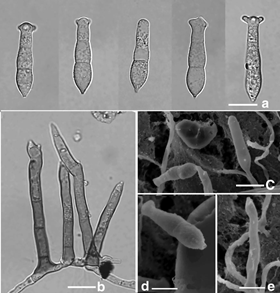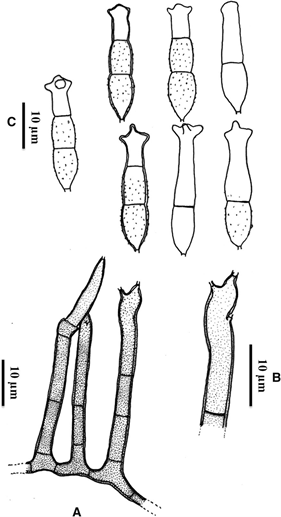Pseudocoronospora hainanense Z.F. Yu, M. Qiao & R.F. Castan˜eda, sp. nov. (Figs. 5 and 6).
MycoBank number: MB 840433; Index Fungorum number: IF 840433; Facesoffungi number: FoF 11945;
Etymology: Epithet refers to the region Hainan where the type strain was collected.
Asexual morph hyphomycetous. Colonies on CMA attaining 3 cm diam. after 20 days at 25 °C, effuse, white to pale flesh, reverse buff. Hyphae thin-walled, septate, hyaline, smooth. Conidiophores macronema- tous, mononematous, straight or slightly flexuous, somewhat geniculate toward the apex, septate, unbranched, smooth, mid brown or pale brown below, pale brown to subhyaline towards the apex, 16.5–49 9 3.5–5.0 lm. Conidiogenous cells poly- blastic, sympodial extended, integrated, terminal, sometimes intercalary, indeterminate, pale brown to subhyaline, denticulate, denticle conspicuous, nar- rowly cylindrical. Conidial secession rhexolytic. Conidia solitary, acropleurogenous, obclavate, crowned with 2–3 broadly mammiform protuber- ances, radially arranged near the rounded to obtuse apex; 2-septate, smooth or slightly verruculose at the basal and central cells, hyaline, 27.2–33 9 3.7–8.0 lm, with a minute basal frill. Sexual state: Unknown.
Holotype: YMF 1.04517, isolated from leaves of an unidentified dicotyledonous plant submerged in a stream, Diaoluoshan National Forest Park, Hainan Province, China, 18°4201100N, 109°5301600E, ca. 1124 m elev., April 2014, Zefen Yu, permanently preserved in a metabolically inactive state (deep freezing) in the Conservation and Utilization of Bio- Resources in Yunnan. Ex-type culture CCTCC AF 2,021,129 = CGMCC 3.18823.

Fig. 5 Pseudocoronospora hainanense (YMF 1.04517). a, d Conidia. b, e Conidiophores and conidiogenous cells. c Conidia with conidiogenous cells. c, d, e were taken with SEM. Scale bars: (a–e) = 10 lm

Fig. 6 Drawing of Pseudocoronospora hainanense made by R.F. Castan˜eda-Ruiz. a Conidiophores and conidiogenous cells. b Conidiogenous cells. c Conidia
